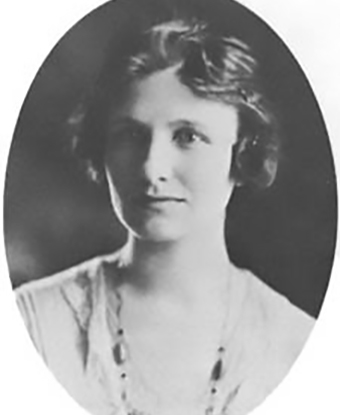Last updated: August 31, 2020
Person
Winifred Bartlett

NPS, Pipestone National Monument
Snow swirled on a cold night in January 1932 as 35 members of the Pipestone community gathered in the Calumet Hotel. They sought to form a permanent organization to advocate for preservation of the beloved pipestone quarries. Shrewd and determined, Winifred Bartlett became their president, and served as a driving force for the establishment of Pipestone National Monument.
Winifred Bartlett was born in 1885 on a farm located a few miles north of the pipestone quarries. From an early age, she enjoyed exploring the area surrounding the quarries on foot. She frequently visited the site to take in views of the falls, examine the wildflowers, and watch the quarriers work. Her interest in preservation developed as she began to understand the historical and cultural significance of the location. Shejoined the local Catlinite Chapter of the Daughters of the American Revolution (DAR) and strongly supported the organization’s movements to protect the inscriptions left by the Nicollet expedition and preserve the native prairie wildflowers.
Winifred trained as a teacher, but eventually pursued a career in the court systems. In the mid-1920s, she served as a court reporter during the settlement case between the Ihanktonwan/Yankton Tribe and the federal government, in which the Tribe was compensated to clear the land title claim to the Pipestone Indian Reservation. Through this case, the land title of the pipestone quarries was transferred over to the U.S. Government, with the provision that American Indians would be granted access to the quarries for as long as they so desired. During her exposure to this case, Winifred gained an appreciation for tribal traditions and belief systems, and heard first-hand accounts from tribal elders relating the difficulties facing those who wished to travel to the pipestone quarries. These experiences shifted Winifred’s focus to the need for stronger protection of the cultural aspects of the site. In 1927, Winifred became the first female county clerk of court in Minnesota, and through this position she made professional acquaintances with bureaucrats in larger cities, which allowed her to elevate her advocacy for protection of the pipestone quarries.
Winifred Bartlett was recognized as a strong civic activist in the Pipestone community. She led the local DAR chapter and spearheaded the group’s efforts to preserve significant features, including the area of the Three Maidens. On January 14, 1932, when nearly 40 members of Pipestone civic, social, religious, and governmental groups gathered in the Calumet Hotel to form the Pipestone National Park Association (quickly renamed the Pipestone Indian Shrine Association, as the group desired more of a cultural preserve than a recreational park), Winifred was easily elected President due to her local expertise and enthusiasm. Over the next few years, the group lobbied for federal protection of the area, and Winifred self-funded her travel to Washington, D.C., to speak in favor of designating a national park at the site. Eventually, on August 25, 1937, Congress approved the act to establish Pipestone National Monument. Winifred Bartlett continued to be involved with the Monument and the Pipestone community, and was present at the ribbon cutting ceremony for the new visitor center built in 1958. She died in 1982 at the age of 96, and is buried at Woodlawn Cemetery.
